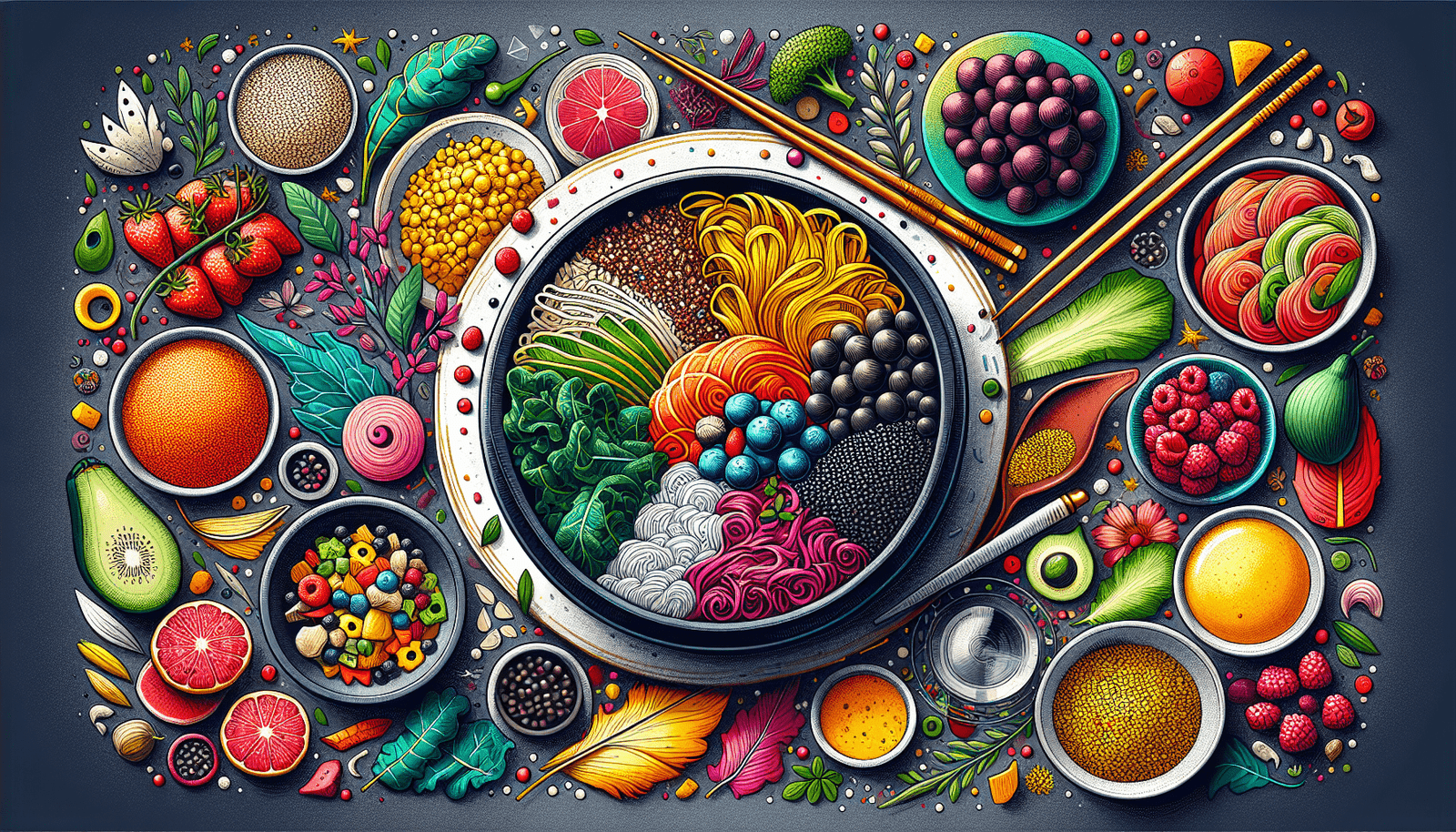In the culinary world, there is a growing trend of incorporating global superfoods into traditional dishes, and nowhere is this more evident than in the fusion of Korean cuisine with these powerful ingredients. From the mountains of South America to the shores of Africa, chefs are embracing the nutritional benefits and unique flavors of superfoods such as quinoa, moringa, and baobab and skillfully infusing them into Korean recipes. Join us as we explore the exciting ways chefs are reimagining Korean cuisine, offering a new twist on classic dishes that is both delicious and healthy.

Introduction
In today’s globalized world, the boundaries of cuisine are constantly being pushed and expanded. Chefs all over the world are embracing the concept of fusion cuisine, incorporating elements and ingredients from various culinary traditions to create unique and exciting dishes. One particular trend that has gained significant popularity is the use of global superfoods in traditional recipes. Superfoods, by definition, are nutrient-dense foods that offer a wide array of health benefits. In this article, we will explore how chefs are incorporating global superfoods into Korean dishes, the benefits and challenges of doing so, and the culinary innovation that arises from this fusion.
Understanding Global Superfoods
Definition of superfoods
Superfoods are foods that are exceptionally nutrient-dense and have been scientifically proven to provide various health benefits. They are typically rich in vitamins, minerals, antioxidants, and phytochemicals, which are naturally occurring compounds that have been linked to improved health and disease prevention. Some examples of well-known superfoods include berries, leafy greens, nuts, and seeds.
Popular global superfoods
With the increasing popularity of superfoods worldwide, a wide range of ingredients from different cultures have been dubbed as “superfoods.” Some of the most popular global superfoods include quinoa, chia seeds, goji berries, and seaweed. These ingredients have gained recognition for their unique nutritional profiles and versatility in cooking.
Benefits of incorporating superfoods into dishes
Incorporating superfoods into dishes offers numerous benefits. Firstly, they provide an enhanced nutritional profile, ensuring that meals are packed with essential vitamins, minerals, and antioxidants. Secondly, they offer increased variety and options for those with specific dietary preferences, such as vegetarian or gluten-free diets. Lastly, they add unique flavors and textures to traditional dishes, imparting a modern twist and exciting culinary experience.
Korean Cuisine and Traditional Ingredients
Overview of Korean cuisine
Korean cuisine is known for its bold flavors and diverse range of dishes. It is characterized by the use of fermented foods, spicy sauces, and a variety of vegetables and proteins. Korean cuisine has a long history and is deeply rooted in tradition, with many recipes being passed down through generations.
Traditional Korean ingredients and flavors
Traditional Korean cooking incorporates a range of ingredients that are essential to achieving the distinct flavors of the cuisine. These include gochujang (fermented chili paste), doenjang (fermented soybean paste), sesame oil, garlic, and ginger. These ingredients contribute to the umami-rich and spicy flavors that are synonymous with Korean cuisine.
Role of fermentation in Korean cooking
Fermentation plays a crucial role in Korean cooking. It is a traditional preservation method that not only extends the shelf life of ingredients but also enhances their flavors. Fermented foods such as kimchi, soybean paste, and fermented seafood are staples in Korean cuisine. Fermentation not only adds depth and complexity to dishes but also promotes a healthy gut microbiome, aiding digestion and overall well-being.
Trends in Fusion Cuisine
Emergence of fusion cuisine
Fusion cuisine refers to the blending of culinary traditions and techniques from different cultures. It is a growing trend in the culinary world as chefs seek to create innovative and unique dishes that combine the best elements of various cuisines. Fusion cuisine allows for diverse flavors and ingredients to come together harmoniously, resulting in exciting and memorable dining experiences.
Influence of global food trends on Korean cuisine
Korean cuisine has been significantly influenced by global food trends. With increased globalization and accessibility to ingredients from around the world, Korean chefs have been able to experiment with and incorporate global superfoods into traditional dishes. This has allowed for the fusion of flavors, textures, and nutritional benefits, creating dishes that are both visually appealing and satisfying to the palate.
Increasing demand for healthy and diverse options
There is a growing demand for healthy and diverse dining options. As people become more conscious of their health and dietary choices, chefs are finding creative ways to meet these demands. Incorporating global superfoods into Korean dishes allows for a wider range of choices, catering to different dietary preferences while maintaining the rich and authentic flavors of Korean cuisine.

Incorporating Global Superfoods into Korean Dishes
Exploring new ingredients from around the world
To incorporate global superfoods into Korean dishes, chefs have been exploring new ingredients from around the world. They are sourcing ingredients such as quinoa, chia seeds, goji berries, and seaweed to bring new flavors and nutritional benefits to traditional Korean recipes. By incorporating these ingredients, chefs are able to impart a modern and global touch to their dishes.
Replacing traditional ingredients with superfood alternatives
Another approach to incorporating superfoods into Korean cuisine is by replacing traditional ingredients with superfood alternatives. For example, quinoa can be used as a substitute for rice in Korean bibimbap, adding an extra nutritional punch. Chia seeds can be added to kimchi for added texture and health benefits. By substituting traditional ingredients, chefs are able to give a contemporary twist to classic Korean dishes without compromising their authenticity.
Experimenting with flavors and textures
Incorporating global superfoods allows chefs to experiment with different flavors and textures in Korean dishes. For instance, adding goji berries to a seaweed soup provides a sweet and tart contrast to the savory flavors. Ginseng-infused chicken stew combines the earthy flavors of ginseng with the comforting warmth of traditional Korean stews. These creative combinations not only enhance the taste of the dish but also introduce new and exciting culinary experiences to diners.
Examples of Superfood-infused Korean Dishes
Quinoa Bibimbap
Quinoa Bibimbap is a modern twist on the traditional Korean dish. Instead of using rice, quinoa is used as the base, providing a nutty flavor and added protein. The dish is topped with a variety of colorful vegetables, a fried egg, and a spicy gochujang sauce. The combination of the superfood quinoa and traditional Korean flavors creates a healthy and satisfying meal.
Kimchi with Chia Seeds
Chia seeds are a rich source of omega-3 fatty acids, fiber, and various vitamins and minerals. By adding chia seeds to kimchi, a staple in Korean cuisine, chefs are not only enhancing the nutritional value of the dish but also adding a delightful crunch. The chia seeds absorb the flavors of the kimchi, making it a flavorful and nutritious addition to any meal.
Seaweed and Goji Berry Soup
Seaweed is a nutrient-rich superfood that is commonly used in Korean cuisine. By incorporating goji berries into a seaweed soup, chefs are introducing a new flavor profile that adds sweetness and tang to the dish. The combination of seaweed’s umami taste and goji berries’ fruity undertones creates a unique and refreshing soup that is both healthy and delicious.
Ginseng-infused Chicken Stew
Ginseng is a medicinal herb that is widely used in traditional Korean medicine. By infusing ginseng into a chicken stew, chefs are adding a new layer of flavor and health benefits to the dish. Ginseng is believed to boost immunity and improve overall well-being. The earthy flavors of ginseng complement the rich and comforting flavors of the chicken stew, resulting in a hearty and nourishing meal.

Benefits and Challenges of Incorporating Superfoods
Enhanced nutritional profile
One of the main benefits of incorporating superfoods into Korean dishes is the enhanced nutritional profile. Superfoods are packed with vitamins, minerals, and antioxidants, offering a wide range of health benefits. By including these ingredients in traditional Korean recipes, chefs are able to create dishes that are not only delicious but also highly nutritious, promoting overall well-being.
Increased variety and options for dietary preferences
Incorporating superfoods into Korean cuisine provides increased variety and options for individuals with specific dietary preferences. Superfoods such as quinoa and chia seeds are gluten-free alternatives to traditional grains, making them suitable for those with gluten sensitivities or celiac disease. Additionally, superfoods cater to vegetarian and vegan diets, offering plant-based sources of protein and essential nutrients.
Maintaining authenticity and balance in flavors
While incorporating superfoods into Korean dishes offers exciting opportunities for culinary innovation, it is important to maintain the authenticity and balance of flavors. It is crucial for chefs to understand the traditional foundations of Korean cuisine and ensure that the incorporation of superfoods does not overshadow or overpower the original flavors. Skillful balance and thoughtful execution are key to preserving the essence of Korean cuisine while embracing the benefits of global superfoods.
Accessibility and affordability of global superfoods
One of the challenges chefs may face when incorporating global superfoods into Korean dishes is the accessibility and affordability of these ingredients. While the availability of superfoods has increased over the years, some ingredients may still be challenging to source in certain regions. Additionally, the cost of these ingredients may be higher compared to traditional Korean ingredients. Chefs need to carefully consider the practicality of using global superfoods, weighing the benefits against the logistical and financial challenges.
Culinary Innovation and Creativity
Collaboration between chefs and food scientists
Incorporating global superfoods into Korean cuisine requires a balance between culinary innovation and scientific knowledge. Chefs often collaborate with food scientists to understand the properties and potential applications of superfoods. This collaboration allows for the development of innovative cooking techniques and recipes that truly highlight the unique qualities of these ingredients.
Adapting traditional recipes to modern palates
Incorporating global superfoods into Korean dishes often involves adapting traditional recipes to suit modern palates. Chefs need to find the right balance between introducing new flavors and maintaining the familiarity of traditional Korean cuisine. By carefully selecting and incorporating global superfoods, chefs can create dishes that are both rooted in tradition and appealing to contemporary taste preferences.
Development of unique and exciting flavor combinations
The incorporation of global superfoods into Korean cuisine opens up a world of possibilities for flavor combinations. Chefs have the opportunity to experiment with contrasting tastes, textures, and aromas. This creative process can result in the development of unique and exciting flavor profiles that push the boundaries of traditional Korean cuisine. The use of global superfoods allows chefs to take diners on a culinary adventure, showcasing the versatility and innovation that can be achieved through fusion cooking.

Health and Wellness Considerations
Promoting healthier eating choices
By incorporating superfoods into Korean dishes, chefs are promoting healthier eating choices. Superfoods are known for their high nutritional content and health benefits, making them an excellent addition to any diet. By showcasing superfood-infused Korean dishes, chefs can inspire diners to make healthier choices and prioritize their well-being.
Addressing dietary restrictions and allergies
Another important consideration when incorporating superfoods into Korean dishes is addressing dietary restrictions and allergies. Chefs need to be mindful of common allergens and dietary restrictions such as gluten intolerance or nut allergies. By using superfoods that are naturally gluten-free or nut-free, chefs can create inclusive and safe dining options for individuals with specific dietary needs.
Cultural and social impact of food choices
The incorporation of global superfoods into Korean cuisine also has cultural and social implications. It highlights the interconnectedness of different culinary traditions and the power of food to transcend cultural boundaries. By embracing global superfoods, chefs are not only offering new and exciting dishes but also promoting cultural exchange and understanding through the medium of food.
Conclusion
The incorporation of global superfoods into Korean cuisine represents a harmonious blend of tradition and innovation. By embracing the benefits of superfoods and combining them with the rich flavors and techniques of Korean cooking, chefs are able to create dishes that are both nourishing and deeply satisfying. Through fusion cuisine, culinary innovation, and collaboration, chefs are pushing the boundaries of what is possible in the culinary world. By incorporating global superfoods into Korean dishes, diners can experience the best of both worlds – the cultural heritage of Korean cuisine and the health benefits of superfoods – all in one delicious meal. So why not embark on a culinary adventure and explore the exciting world of superfood-infused Korean dishes? Your taste buds and your health will thank you!

